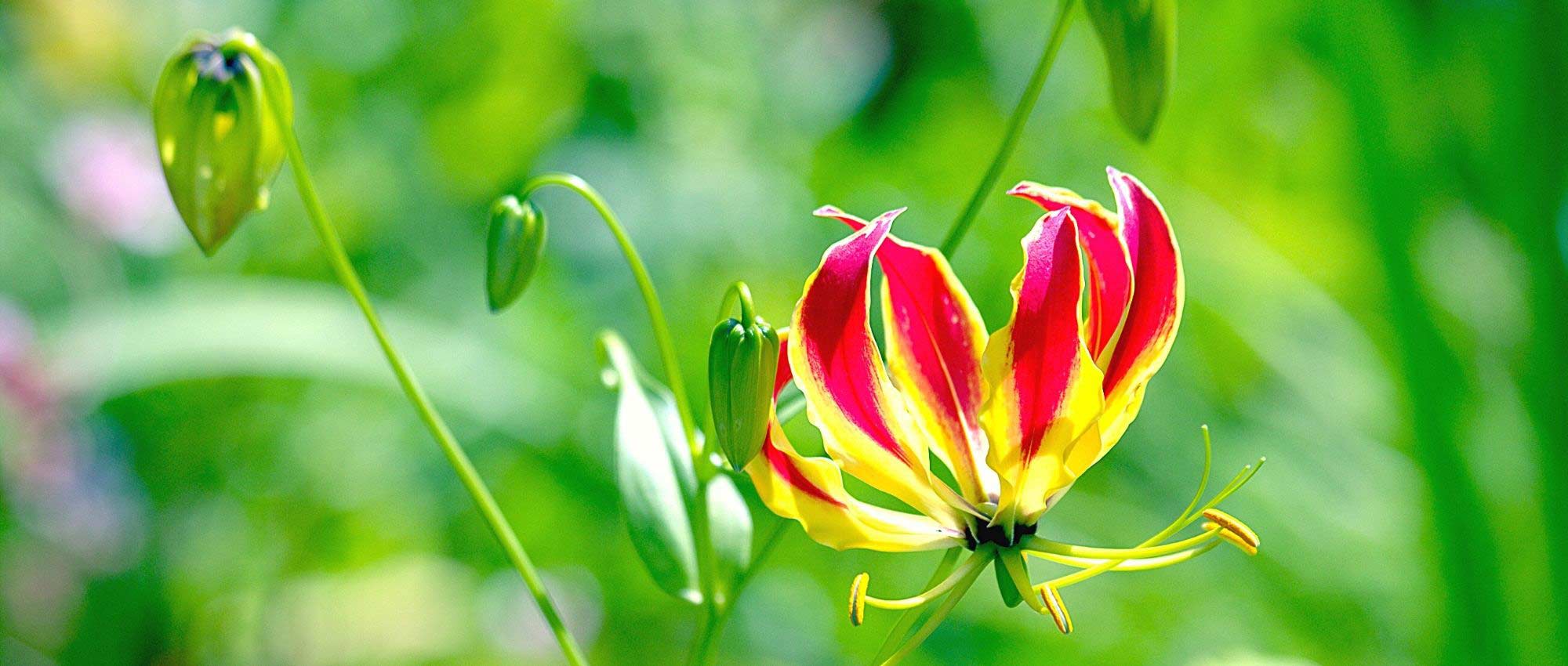
Gloriosa: Planting, Growing and Care
Contents
Gloriosa in a nutshell
- The Gloriosa offers a spectacular flowering with large red and yellow flowers!
- It is an extremely vigorous climbing plant that can be seen growing day by day.
- Its leaves are decorative and bear small tendrils at their tips.
- It has a truly tropical and exotic style.
- It is mainly grown in pots, to be brought under cover for the winter.
A word from our Expert
The Gloriosa superba or Malabar Lily is a splendid exotic climbing plant that produces large, brightly coloured flowers (red, orange, yellow) that resemble lily flowers. It also boasts beautiful, bright green, glossy foliage, with charming tendrils at the tips of the leaves, allowing it to cling to its support effortlessly! The most commonly cultivated variety is Gloriosa superba ‘Rothschildiana’, featuring large, vivid red flowers edged in yellow, and the lovely variety Gloriosa superba ‘Lutea’, which has entirely yellow flowers. Everything about this plant is highly decorative: its beautiful bright green leaves, finished with small tendrils, its climbing habit, its flowers, and even its flower buds!
The Gloriosa is a tender plant that needs protection in winter. It is generally grown in pots, which can be placed in a greenhouse or conservatory, or taken out onto the terrace and brought back in during autumn. It is also possible to plant it in the garden, in a summer bed, and to bring it in at the end of the season… just like cannas or dahlias. In any case, the Gloriosa cannot survive the winter outdoors!
The Gloriosa develops from a tubercle (toxic if ingested): plant it in spring, and you will see the stems emerge very quickly! It is a particularly vigorous plant and very easy to grow. However, it does appreciate regular watering and some fertiliser.
Botany
Botanical data
- Latin name Gloriosa superba
- Family Colchicaceae
- Common name Glory lily, Malabar lily
- Flowering summer, often between June and August
- Height 1.5 to 2 m
- Exposure full sun
- Soil type well-drained, rich
- Hardiness 5 to 10 °C
The Gloriosa or Malabar lily is a stunning climbing plant that encompasses 10 species native to South-Eastern and tropical Africa, Madagascar, and India. It is, in fact, the national flower of Zimbabwe! The Gloriosa grows in various habitats: primarily in humid forests, sometimes along riverbanks, but also more rarely in open areas, such as meadows. The most commonly cultivated variety is Gloriosa superba ‘Rothschildiana’.
Both the flowers, with their highly developed petals and prominent stamens, and the leaves of the Gloriosa resemble those of the lily! It was previously classified in its own family, the Liliaceae, but has since been reclassified into the family of colchicums, the Colchicaceae (284 species). This is a somewhat unique family of plants that includes Colchicum, as well as the lesser-known Sandersonia, Uvularia, and Disporum, which offer original bell-shaped flowers.
The Gloriosa is a rapidly growing climbing plant that gradually wraps its tendrils around its support. It can reach up to 4 metres high in its natural habitat, but in our climates, it does not exceed 1.5 to 2 m. The stems are thick and robust, reflecting the plant’s vigour. The Gloriosa is not a small, timid, and fragile plant: on the contrary, it is a plant that asserts itself and impresses!
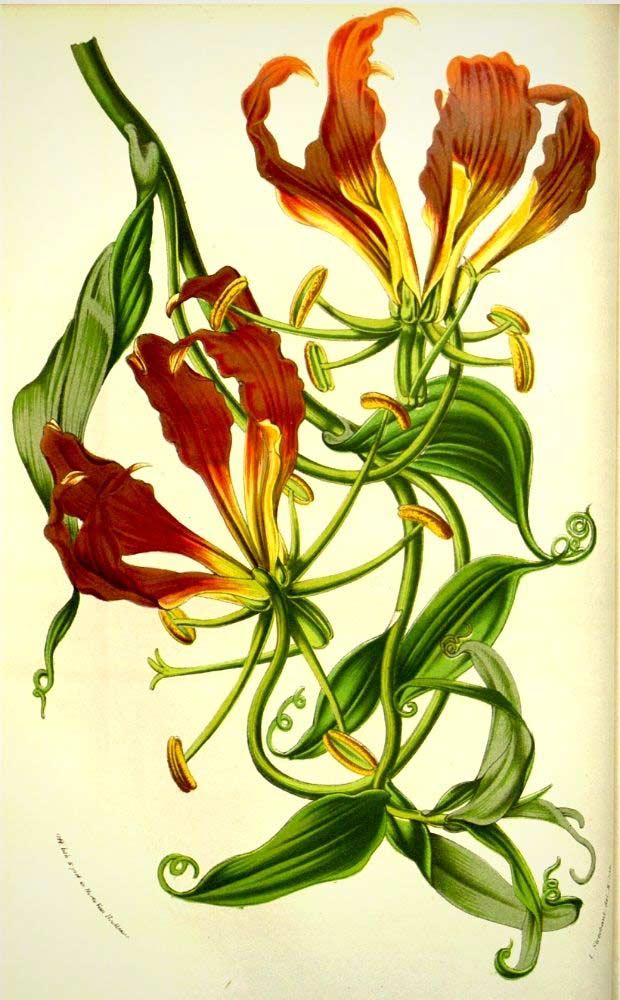
Gloriosa superba: Botanical illustration
The Gloriosa develops from an underground tuber, elongated and fleshy, which over time takes on a V shape. This is a storage organ: the plant accumulates nutrients and stores them in its tuber, then the foliage withers in autumn, and the plant spends the harsh season in the soil, in the form of a tuber. In spring, as soon as the soil warms up, the accumulated reserves will allow the Gloriosa to develop its stems and first leaves again, from which it can resume photosynthesis and accumulate new reserves.
The Gloriosa flowers in summer, usually between June and August, sometimes extending into early autumn. The flowers gradually bloom one after another. Each flower does not last long, but they quickly take turns. The flowers appear at the top of the plant; they are solitary and inserted at the axil of the leaves by a long peduncle.
When it reaches the top of its support, or when it has attained sufficient height, the Gloriosa stops its growth to focus on flowering. It seems to suddenly halt its growth… then small floral buds gradually emerge, which become larger and larger. They are very decorative and resemble small lanterns, somewhat like those of Physalis, but smaller, greener, and more elongated.
Gradually, the floral buds swell, and the petals become increasingly visible. Then they open, the petals lift, ultimately curling back at the top of the flower. They gradually change colour: from green, they turn yellow, then orange, and finally bright red! The base of the petals remains yellow, creating a lovely contrast! Similarly, the petals are often edged in yellow.
The flowers of the Gloriosa are large (generally 7 to 10 cm in diameter) and consist of six large tepals (three petals and three identical sepals), with beautifully undulating edges. The petals are recurved, inclined towards the back of the flower, upwards, making the stamens clearly visible below. There are six of them, large, prominent, and widely spaced apart. They are accompanied by a long, curved style, forming an angle, which divides into three segments at its tip. The style is also very large and clearly visible. The stamens bear yellow-orange pollen, which easily detaches when the flower is touched. Unlike most flowers, all the reproductive organs of the Gloriosa are large and decorative. The flowers are structured like those of lilies: with six large free tepals, six stamens, and a long style. They are drooping, oriented towards the ground, and have a truly light and airy style. Given the beauty of its flowering, the name Gloriosa superba suits it perfectly! The red and yellow petals, upright and undulating, resemble flames… earning it the English nickname Flame lily!

The flowering of the Gloriosa: floral buds and flowers of Gloriosa superba and Gloriosa lutea (photos Maja Dumat, manuel m. v. and Bernard Dupont)
The ‘Rothschildiana’ variety has slightly larger flowers and a deeper red than the typical species. Its flowers then turn ruby red or garnet. There is also a variety with entirely yellow flowers: Gloriosa lutea, or Gloriosa superba ‘Citrina’.
Once flowering is complete, the Gloriosa forms thick capsules, which contain three chambers and hold the seeds. They open at maturity to allow the seeds to disperse.
The Gloriosa has very beautiful foliage with a lush, exotic style. The leaves are large, between 5 and 10 cm long, and oval. They have a lovely bright green colour and are shiny. They end in a small tendril, which allows the plant to cling to its support.
Interestingly, the leaves are most often alternate, but they can also be opposite or even whorled! There seems to be no real rule: they are inserted on the stem in a more or less random manner!
The foliage of the Gloriosa is deciduous: after flowering, the entire aerial system (leaves and stems) withers. It should then be cut back and the pot brought indoors.
Like its cousins the colchicums, all parts of the plant are toxic, as they contain an alkaloid, colchicine. In fact, they contain more than the colchicums themselves.

The foliage of the Gloriosa, with a detail of the tendrils at the tips of the leaves (photos Maja Dumat, SAplants and P Jeganathan)
The main varieties
The most popular varieties
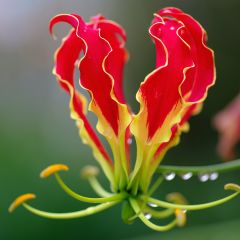
Gloriosa superba Rothschildiana - Glory Lily
- Période de floraison July to September
- Hauteur 2 m
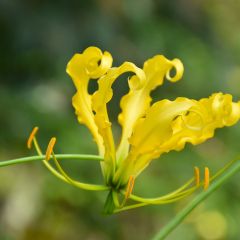
Gloriosa lutea - Glory Lily
- Période de floraison August to October
- Hauteur 1,50 m

Gloriosa superba Mix - Glory lily
- Période de floraison July to September
- Hauteur 1,80 m
Planting
Where to plant?
Due to its low hardiness, Gloriosa is primarily grown in pots. Ideally, it should be placed in a conservatory or a temperate greenhouse, allowing you to keep it in place all year round, even in winter. Gloriosa also fits well on a terrace, in full sun. Just remember to bring it indoors for the winter.
However, it is possible to grow Gloriosa in the ground by planting it in spring, as soon as there is no longer a risk of frost, and by digging it up in autumn to winter its tubercle… just as you would for dahlias or cannas. Choose a well-sunny spot that is sheltered from the wind. Regarding soil type, Gloriosa prefers rich, well-draining soils without excess moisture. It is advisable to add some compost to enrich the soil and coarse sand for drainage. You can plant it at the base of a pergola, trellis, or any support it can cling to.
Gloriosa is sometimes sold as a houseplant, but it requires a very bright, if not sunny, location, making it more suitable for greenhouses or conservatories rather than the interiors of homes or apartments, which may be too dark for it.
When to plant?
Plant Gloriosa in spring, around May, as soon as there is no longer a risk of frost. You can also plant it earlier in a pot, keeping it indoors or in a conservatory, then move it to the terrace as soon as it is warm enough.
How to plant?
We recommend growing Gloriosa in a pot, as this makes it easier to winter the tuber. If you plant it in the ground, you risk damaging the tubers when digging them up in autumn, as they are quite fragile. You can also plant in a pot and bury it in the garden.
In any case, be careful when handling the tubers: they break easily.
For pot planting:
- Choose a large pot, wide and deep, with drainage holes at the bottom.
- Fill it with a mix of garden soil and potting soil, combined with coarse sand.
- Plant the tuber flat. It should be buried under 6 to 10 cm of soil.
- Cover it with substrate.
- Water.
- Place the pot in a bright location, in a greenhouse or conservatory, or on your sunny terrace. You can also initially place the pot indoors, under cover, then move it to the terrace as soon as there is no longer a risk of frost.
- Also, consider installing a support or trellis for Gloriosa to climb on.
→ Learn more with our advice sheet: Growing Gloriosa in a pot
In the ground:
- Choose a well-sunny location, sheltered from cold winds, and dig a planting hole.
- Mix some well-decomposed compost and coarse sand into your garden soil.
- Plant the tuber flat, ensuring it is buried under 6 to 10 cm of soil.
- Cover it with soil, then lightly firm it down.
- Water.
- Install a trellis or support for Gloriosa to climb on.
Continue to water regularly in the weeks following planting.
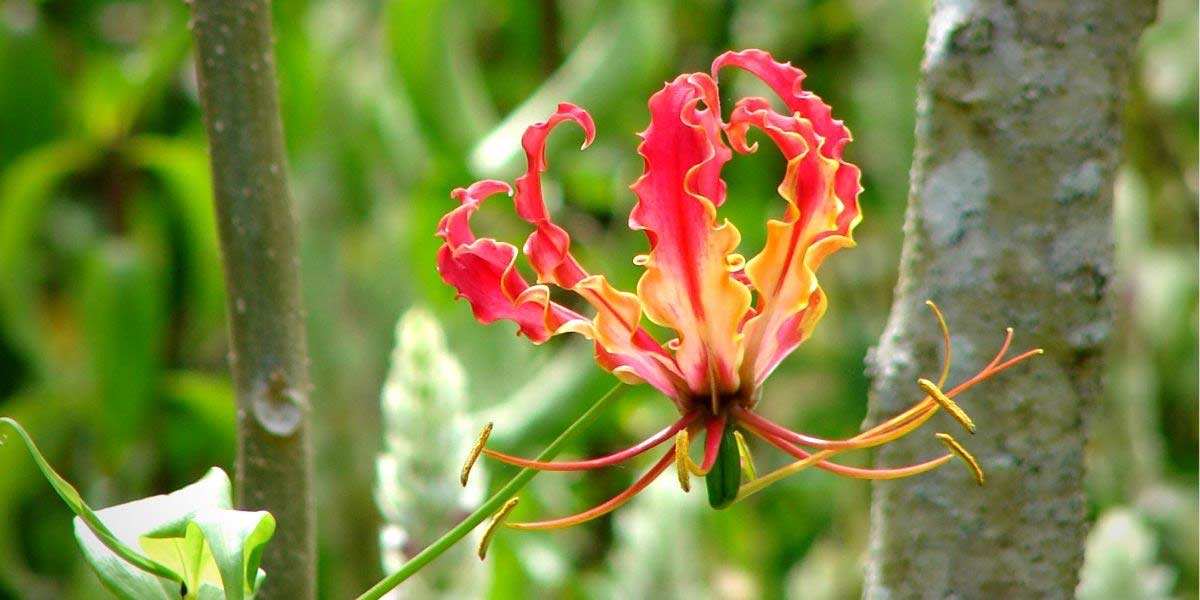
Gloriosa superba ‘Rothschildiana’ (photo Forest and Kim Starr)
Entretien
For maintenance, we recommend watering the Gloriosa regularly (especially if you are growing it in a pot!), at a rate of once or twice a week. Allow the substrate to dry briefly between waterings. If you have placed a saucer under the pot, be careful not to let the water stagnate. If your pot is outdoors, for example on the terrace, it is better not to use a saucer. We also advise providing liquid fertiliser throughout the growth and flowering period, at a rate of one application every 15 days. Remember to repot the Gloriosa from time to time, preferably at the end of winter.
Normally, the tendrils will cling to their support on their own, but you can assist them if they cannot find it by themselves.
Cut off any faded flowers as you see them, for aesthetic reasons and to encourage the appearance of new flowers.
In autumn, cut back the aerial parts once they are completely dry (not before!). If the pot was outdoors on your terrace, bring it under cover and stop watering to prevent the tubercle from rotting.
For winter, store the pot in a sheltered, dry place. The plant is dormant: avoid any watering or fertiliser application. It does not need it, and this could risk rotting the tubercle.
If you planted it in the ground, dig up the tubercle in autumn, digging wide enough not to damage it, then lift it out and bring it under cover, to a dry, dark, and ventilated spot. Wait until spring to replant it in the garden.
Be careful when digging it up as the tuber is fragile! It can break easily. However, even if it breaks, replant both pieces; there is a chance they will regrow, as this is akin to tuber division.
Multiplication
Gloriosa can be propagated by sowing or by dividing tubercles. Division is easier and allows for quicker production of beautiful plants ready to flower.
Sowing
- Before sowing Gloriosa seeds, soak them in lukewarm water for 24 hours. This will aid germination.
- Prepare a pot or seed tray with special seed compost, mixed with a little sand.
- Sow the seeds on the surface.
- Cover them with a thin layer of substrate (0.5 to 1 cm thick).
- Water gently.
- Place the pot in a bright location, at a temperature between 20 and 25 °C.
The substrate should remain slightly moist (but not waterlogged) until germination. Gloriosa seeds generally take 3 to 6 weeks to germinate. Once the seedlings are large enough to handle, repot them into individual pots.
Discover our seeds of Gloriosa superba ‘Mixed’!
Division of Tubercles
Gloriosa is very easy to propagate by division. Do this in spring, just before replanting in pots or in the ground.
- Dig up Gloriosa tubercles in autumn to store them dry for winter, or gently remove them from the ground in spring.
- In spring, when planting, take a relatively large and well-formed Gloriosa tubercle.
- Cut it cleanly in half using a sharp, disinfected knife.
- Immediately replant both sections of the tubercle, in pots or in the ground.
- Water.
Association
We obviously recommend pairing Gloriosa with other exotic-style plants! For example, you can place it on your terrace alongside other tropical plants to grow in large containers and winter over: Strelitzia reginae, banana plants, hibiscus, palms, Brugmansias, Lantanas… You can also create a lush border in the ground near these plants or in the background, with plants featuring generous foliage, such as Tetrapanax, palms, Musa basjoo, Fatsia japonica, Phormiums, Hakonechloa macra ‘Nicolas’… For flowering, consider Crocosmias, Kniphofias, Eucomis, Cardiocrinum giganteum, Cannas… In any case, we advise you to favour flowers in warm tones: red, orange, yellow, possibly with a touch of purple, copper, or chocolate. Gloriosa can also accompany other climbing plants that will ascend a structure or pergola, such as Akebias or passionflowers. Also discover the splendid perennial nasturtium (though semi-hardy), Tropaelum tricolor.
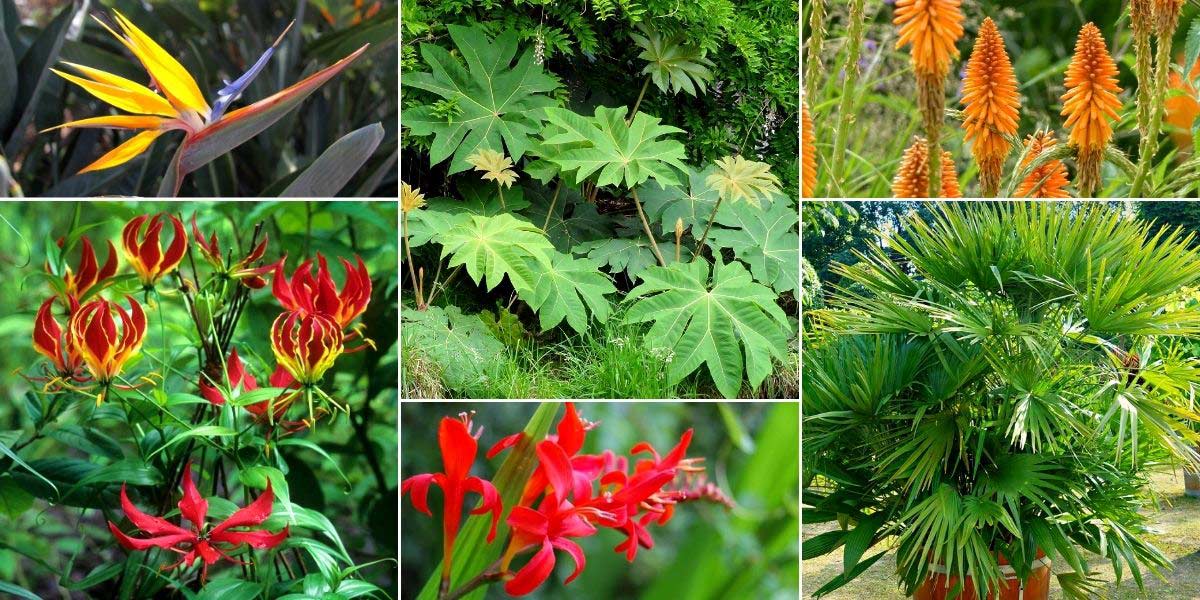
Gloriosa is ideal for accompanying other exotic-style plants! Strelitzia reginae (photo Taty2007), Tetrapanax papyrifera ‘Rex’, Kniphofia ‘Fiery Fred’, Gloriosa superba ‘Rothschildiana’ (photo Andrew Lawson – Flora Press Biosphoto), Crocosmia ‘Lucifer’ (photo Vicky Brock) and Chamaerops humilis
If you plant it in the ground in a summer border, Gloriosa is perfect for accompanying Daylilies, Crocosmias, Kniphofias… for a border with vibrant hues! However, remember to dig up the Gloriosa in autumn, bring it indoors, and replant it the following spring. You can also place it alongside other plants that need winter protection (Dahlias, Cannas…) or frost-sensitive plants grown as annuals: Castor bean, Nasturtiums, Thunbergia alata, Osteospermum, ornamental tobacco, Lantana, Digiplexis… Additionally, to create an original border, you can pair Gloriosa with other rare and exotic bulbs, such as Crinum asiaticum, Ismene festalis, Sprekelia formosissima, Lycoris radiata… Be cautious, as these bulbs are tender and must be brought indoors for winter. Also discover the Cardiocrinum giganteum, which has the advantage of being hardy.
For more pairing ideas, check out our inspiration page “Exotic Ambience”!
Useful resources
- The Gloriosa rothschildiana, the Gloriosa lutea, and if you wish to try sowing, the seeds of Gloriosa superba ‘Mixed’
- An article by Michael on our blog: “Plant Rare Bulbs!”
- Our advice sheet: “Planting Rare and Hardy Bulbs”
- Inspiration: “Exotic Ambience”
- Our advice sheet: Why Isn’t My Gloriosa Flowering?
- Subscribe!
- Contents































Comments